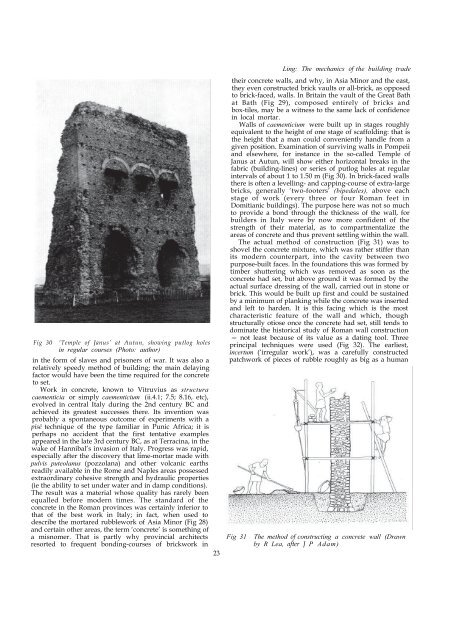ROMAN URBAN TOPOGRAPHY in Britain and the western Empire
ROMAN URBAN TOPOGRAPHY in Britain and the western Empire
ROMAN URBAN TOPOGRAPHY in Britain and the western Empire
You also want an ePaper? Increase the reach of your titles
YUMPU automatically turns print PDFs into web optimized ePapers that Google loves.
Fig 30 ‘Temple of Janus’ at Autun, show<strong>in</strong>g putlog holes<br />
<strong>in</strong> regular courses (Photo: author)<br />
<strong>in</strong> <strong>the</strong> form of slaves <strong>and</strong> prisoners of war. It was also a<br />
relatively speedy method of build<strong>in</strong>g; <strong>the</strong> ma<strong>in</strong> delay<strong>in</strong>g<br />
factor would have been <strong>the</strong> time required for <strong>the</strong> concrete<br />
to set.<br />
Work <strong>in</strong> concrete, known to Vitruvius as structura<br />
caementicia or simply caementicium (ii.4.1; 7.5; 8.16, etc),<br />
evolved <strong>in</strong> central Italy dur<strong>in</strong>g <strong>the</strong> 2nd century BC <strong>and</strong><br />
achieved its greatest successes <strong>the</strong>re. Its <strong>in</strong>vention was<br />
probably a spontaneous outcome of experiments with a<br />
pisé technique of <strong>the</strong> type familiar <strong>in</strong> Punic Africa; it is<br />
perhaps no accident that <strong>the</strong> first tentative examples<br />
appeared <strong>in</strong> <strong>the</strong> late 3rd century BC, as at Terrac<strong>in</strong>a, <strong>in</strong> <strong>the</strong><br />
wake of Hannibal’s <strong>in</strong>vasion of Italy. Progress was rapid,<br />
especially after <strong>the</strong> discovery that lime-mortar made with<br />
pulvis puteolanus (pozzolana) <strong>and</strong> o<strong>the</strong>r volcanic earths<br />
readily available <strong>in</strong> <strong>the</strong> Rome <strong>and</strong> Naples areas possessed<br />
extraord<strong>in</strong>ary cohesive strength <strong>and</strong> hydraulic properties<br />
(ie <strong>the</strong> ability to set under water <strong>and</strong> <strong>in</strong> damp conditions).<br />
The result was a material whose quality has rarely been<br />
equalled before modern times. The st<strong>and</strong>ard of <strong>the</strong><br />
concrete <strong>in</strong> <strong>the</strong> Roman prov<strong>in</strong>ces was certa<strong>in</strong>ly <strong>in</strong>ferior to<br />
that of <strong>the</strong> best work <strong>in</strong> Italy; <strong>in</strong> fact, when used to<br />
describe <strong>the</strong> mortared rubblework of Asia M<strong>in</strong>or (Fig 28)<br />
<strong>and</strong> certa<strong>in</strong> o<strong>the</strong>r areas, <strong>the</strong> term ‘concrete’ is someth<strong>in</strong>g of<br />
a misnomer. That is partly why prov<strong>in</strong>cial architects<br />
resorted to frequent bond<strong>in</strong>g-courses of brickwork <strong>in</strong><br />
23<br />
L<strong>in</strong>g: The mechanics of <strong>the</strong> build<strong>in</strong>g trade<br />
<strong>the</strong>ir concrete walls, <strong>and</strong> why, <strong>in</strong> Asia M<strong>in</strong>or <strong>and</strong> <strong>the</strong> east,<br />
<strong>the</strong>y even constructed brick vaults or all-brick, as opposed<br />
to brick-faced, walls. In Brita<strong>in</strong> <strong>the</strong> vault of <strong>the</strong> Great Bath<br />
at Bath (Fig 29), composed entirely of bricks <strong>and</strong><br />
box-tiles, may be a witness to <strong>the</strong> same lack of confidence<br />
<strong>in</strong> local mortar.<br />
Walls of caementicium were built up <strong>in</strong> stages roughly<br />
equivalent to <strong>the</strong> height of one stage of scaffold<strong>in</strong>g: that is<br />
<strong>the</strong> height that a man could conveniently h<strong>and</strong>le from a<br />
given position. Exam<strong>in</strong>ation of surviv<strong>in</strong>g walls <strong>in</strong> Pompeii<br />
<strong>and</strong> elsewhere, for <strong>in</strong>stance <strong>in</strong> <strong>the</strong> so-called Temple of<br />
Janus at Autun, will show ei<strong>the</strong>r horizontal breaks <strong>in</strong> <strong>the</strong><br />
fabric (build<strong>in</strong>g-l<strong>in</strong>es) or series of putlog holes at regular<br />
<strong>in</strong>tervals of about 1 to 1.50 m (Fig 30). In brick-faced walls<br />
<strong>the</strong>re is often a levell<strong>in</strong>g- <strong>and</strong> capp<strong>in</strong>g-course of extra-large<br />
bricks, generally ‘two-footers’ (bipedales), above each<br />
stage of work (every three or four Roman feet <strong>in</strong><br />
Domitianic build<strong>in</strong>gs). The purpose here was not so much<br />
to provide a bond through <strong>the</strong> thickness of <strong>the</strong> wall, for<br />
builders <strong>in</strong> Italy were by now more confident of <strong>the</strong><br />
strength of <strong>the</strong>ir material, as to compartmentalize <strong>the</strong><br />
areas of concrete <strong>and</strong> thus prevent settl<strong>in</strong>g with<strong>in</strong> <strong>the</strong> wall.<br />
The actual method of construction (Fig 31) was to<br />
shovel <strong>the</strong> concrete mixture, which was ra<strong>the</strong>r stiffer than<br />
its modern counterpart, <strong>in</strong>to <strong>the</strong> cavity between two<br />
purpose-built faces. In <strong>the</strong> foundations this was formed by<br />
timber shutter<strong>in</strong>g which was removed as soon as <strong>the</strong><br />
concrete had set, but above ground it was formed by <strong>the</strong><br />
actual surface dress<strong>in</strong>g of <strong>the</strong> wall, carried out <strong>in</strong> stone or<br />
brick. This would be built up first <strong>and</strong> could be susta<strong>in</strong>ed<br />
by a m<strong>in</strong>imum of plank<strong>in</strong>g while <strong>the</strong> concrete was <strong>in</strong>serted<br />
<strong>and</strong> left to harden. It is this fac<strong>in</strong>g which is <strong>the</strong> most<br />
characteristic feature of <strong>the</strong> wall <strong>and</strong> which, though<br />
structurally otiose once <strong>the</strong> concrete had set, still tends to<br />
dom<strong>in</strong>ate <strong>the</strong> historical study of Roman wall construction<br />
— not least because of its value as a dat<strong>in</strong>g tool. Three<br />
pr<strong>in</strong>cipal techniques were used (Fig 32). The earliest,<br />
<strong>in</strong>certum (‘irregular work’), was a carefully constructed<br />
patchwork of pieces of rubble roughly as big as a human<br />
Fig 31 The method of construct<strong>in</strong>g a concrete wall (Drawn<br />
by R Lea, after J P Adam)

















